2014 KIA Sportage ignition
[x] Cancel search: ignitionPage 22 of 457
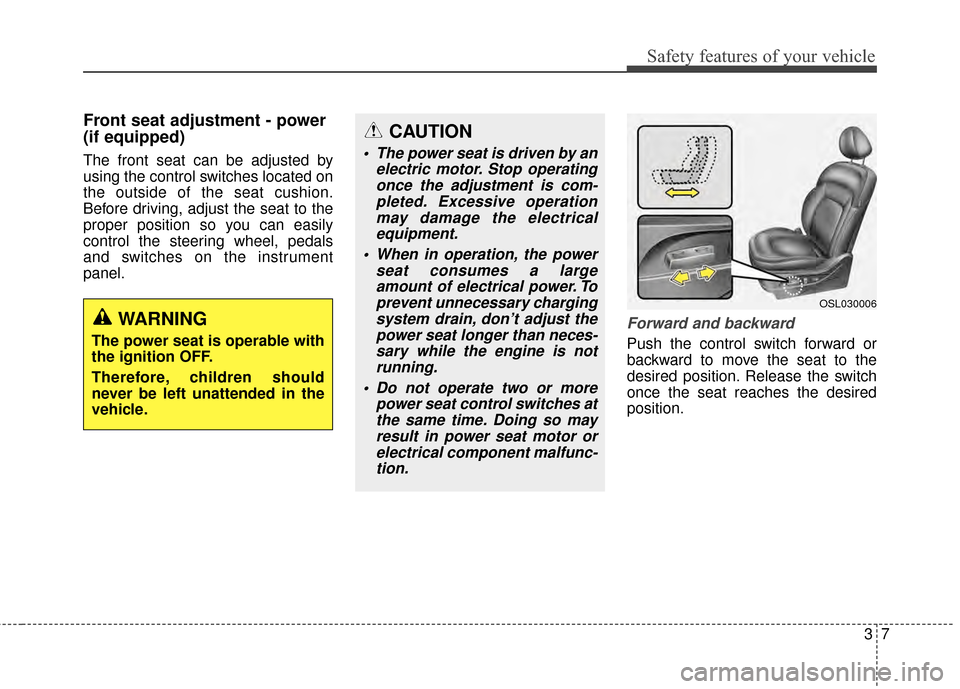
37
Safety features of your vehicle
Front seat adjustment - power
(if equipped)
The front seat can be adjusted by
using the control switches located on
the outside of the seat cushion.
Before driving, adjust the seat to the
proper position so you can easily
control the steering wheel, pedals
and switches on the instrument
panel.
Forward and backward
Push the control switch forward or
backward to move the seat to the
desired position. Release the switch
once the seat reaches the desired
position.
CAUTION
The power seat is driven by anelectric motor. Stop operatingonce the adjustment is com-pleted. Excessive operationmay damage the electricalequipment.
When in operation, the power seat consumes a largeamount of electrical power. Toprevent unnecessary chargingsystem drain, don’t adjust thepower seat longer than neces-sary while the engine is notrunning.
Do not operate two or more power seat control switches atthe same time. Doing so mayresult in power seat motor orelectrical component malfunc-tion.
OSL030006
WARNING
The power seat is operable with
the ignition OFF.
Therefore, children should
never be left unattended in the
vehicle.
Page 28 of 457
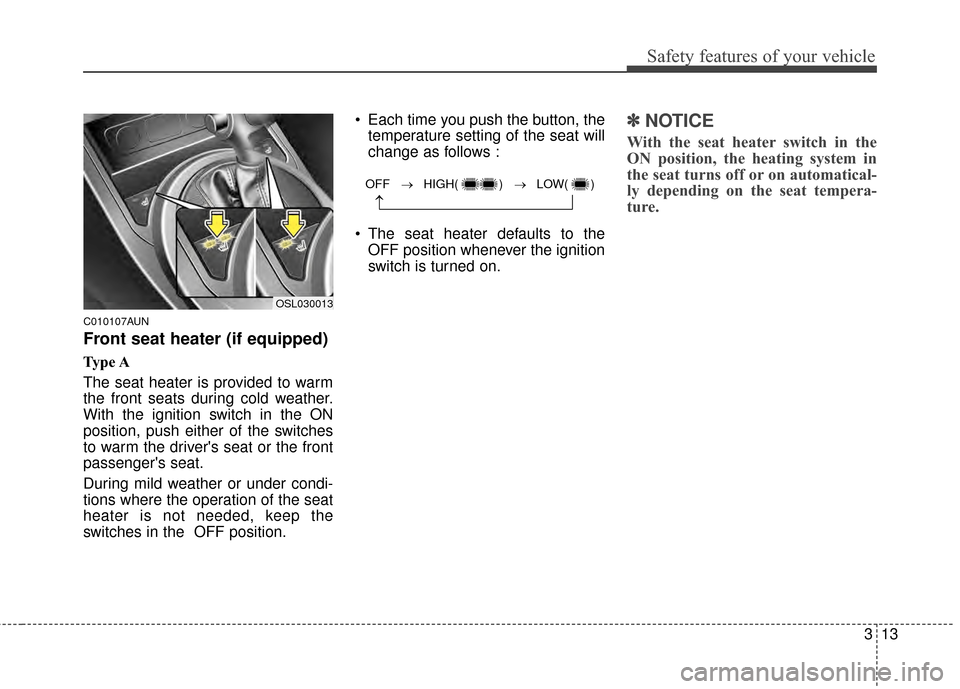
313
Safety features of your vehicle
C010107AUN
Front seat heater (if equipped)
Type A
The seat heater is provided to warm
the front seats during cold weather.
With the ignition switch in the ON
position, push either of the switches
to warm the driver's seat or the front
passenger's seat.
During mild weather or under condi-
tions where the operation of the seat
heater is not needed, keep the
switches in the OFF position. Each time you push the button, the
temperature setting of the seat will
change as follows :
The seat heater defaults to the OFF position whenever the ignition
switch is turned on.
✽ ✽ NOTICE
With the seat heater switch in the
ON position, the heating system in
the seat turns off or on automatical-
ly depending on the seat tempera-
ture.
OSL030013
OFF → HIGH( ) → LOW( )
→
Page 29 of 457
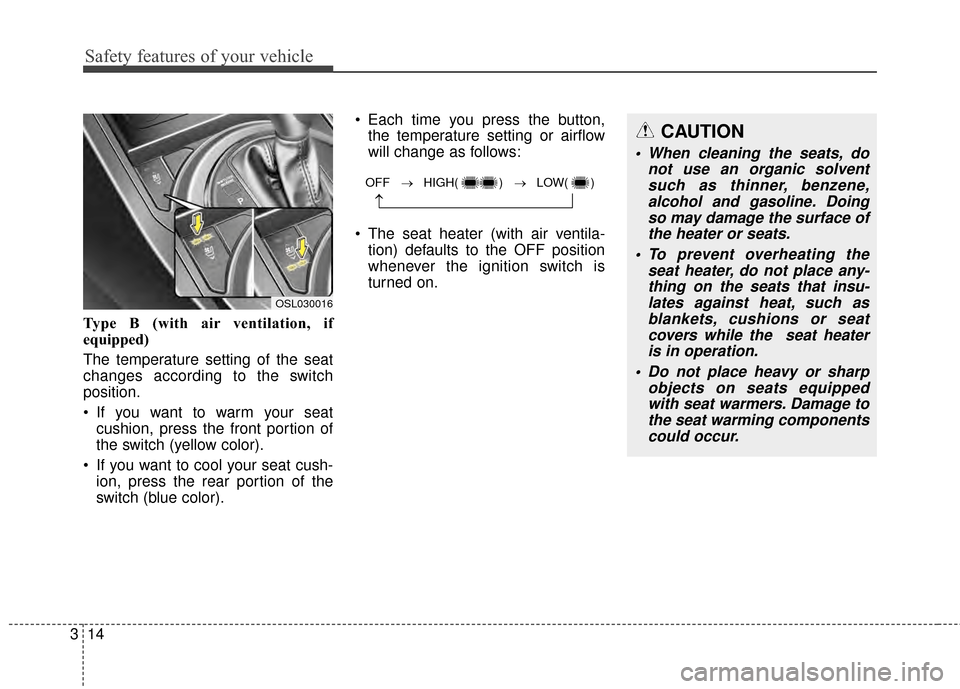
Safety features of your vehicle
14
3
Type B (with air ventilation, if
equipped)
The temperature setting of the seat
changes according to the switch
position.
If you want to warm your seat
cushion, press the front portion of
the switch (yellow color).
If you want to cool your seat cush- ion, press the rear portion of the
switch (blue color). Each time you press the button,
the temperature setting or airflow
will change as follows:
The seat heater (with air ventila- tion) defaults to the OFF position
whenever the ignition switch is
turned on.
OSL030016
OFF → HIGH( ) → LOW( )
→
CAUTION
When cleaning the seats, do not use an organic solventsuch as thinner, benzene,alcohol and gasoline. Doingso may damage the surface ofthe heater or seats.
To prevent overheating the seat heater, do not place any-thing on the seats that insu-lates against heat, such asblankets, cushions or seatcovers while the seat heateris in operation.
Do not place heavy or sharp objects on seats equippedwith seat warmers. Damage tothe seat warming componentscould occur.
Page 36 of 457
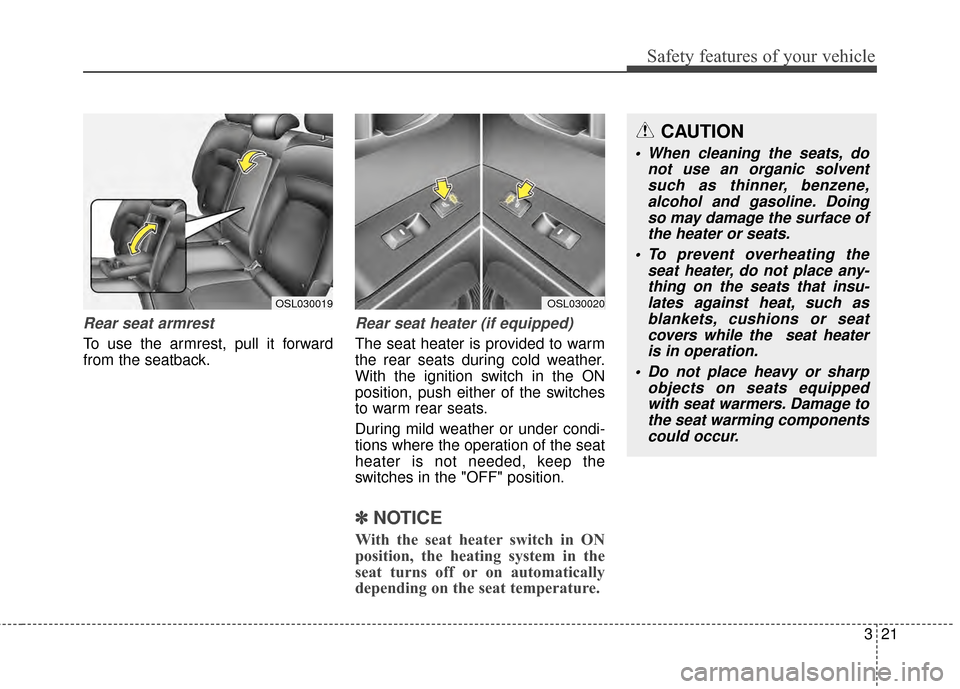
321
Safety features of your vehicle
Rear seat armrest
To use the armrest, pull it forward
from the seatback.
Rear seat heater (if equipped)
The seat heater is provided to warm
the rear seats during cold weather.
With the ignition switch in the ON
position, push either of the switches
to warm rear seats.
During mild weather or under condi-
tions where the operation of the seat
heater is not needed, keep the
switches in the "OFF" position.
✽ ✽NOTICE
With the seat heater switch in ON
position, the heating system in the
seat turns off or on automatically
depending on the seat temperature.
CAUTION
When cleaning the seats, do
not use an organic solventsuch as thinner, benzene,alcohol and gasoline. Doingso may damage the surface ofthe heater or seats.
To prevent overheating the seat heater, do not place any-thing on the seats that insu-lates against heat, such asblankets, cushions or seatcovers while the seat heateris in operation.
Do not place heavy or sharp objects on seats equippedwith seat warmers. Damage tothe seat warming componentscould occur.
OSL030019OSL030020
Page 40 of 457
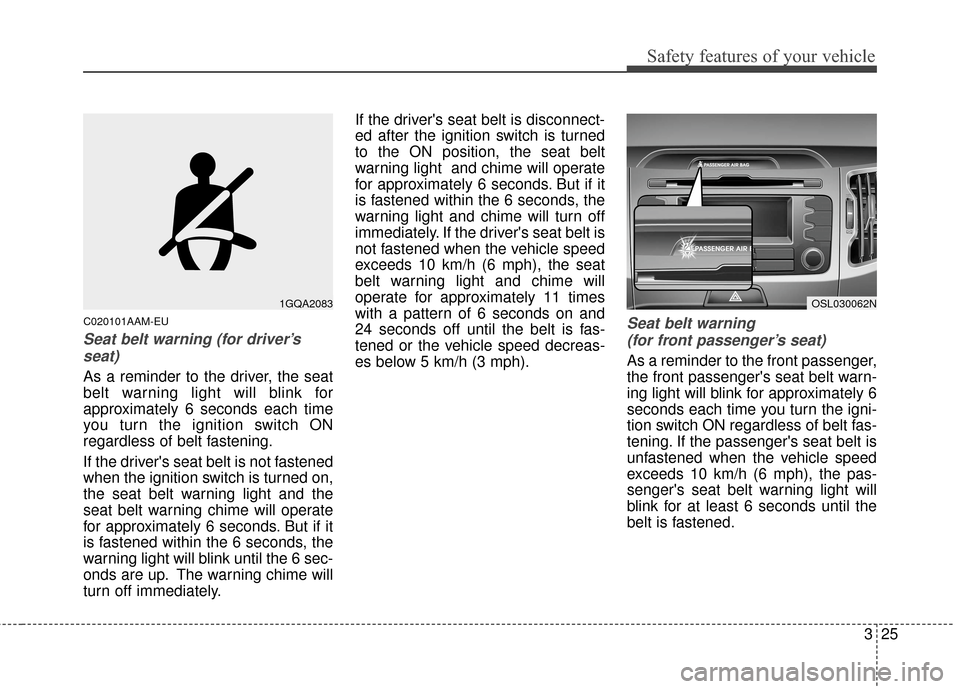
325
Safety features of your vehicle
C020101AAM-EU
Seat belt warning (for driver’sseat)
As a reminder to the driver, the seat
belt warning light will blink for
approximately 6 seconds each time
you turn the ignition switch ON
regardless of belt fastening.
If the driver's seat belt is not fastened
when the ignition switch is turned on,
the seat belt warning light and the
seat belt warning chime will operate
for approximately 6 seconds. But if it
is fastened within the 6 seconds, the
warning light will blink until the 6 sec-
onds are up. The warning chime will
turn off immediately. If the driver's seat belt is disconnect-
ed after the ignition switch is turned
to the ON position, the seat belt
warning light and chime will operate
for approximately 6 seconds. But if it
is fastened within the 6 seconds, the
warning light and chime will turn off
immediately. If the driver's seat belt is
not fastened when the vehicle speed
exceeds 10 km/h (6 mph), the seat
belt warning light and chime will
operate for approximately 11 times
with a pattern of 6 seconds on and
24 seconds off until the belt is fas-
tened or the vehicle speed decreas-
es below 5 km/h (3 mph).
Seat belt warning
(for front passenger’s seat)
As a reminder to the front passenger,
the front passenger's seat belt warn-
ing light will blink for approximately 6
seconds each time you turn the igni-
tion switch ON regardless of belt fas-
tening. If the passenger's seat belt is
unfastened when the vehicle speed
exceeds 10 km/h (6 mph), the pas-
senger's seat belt warning light will
blink for at least 6 seconds until the
belt is fastened.
OSL030062N1GQA2083
Page 49 of 457
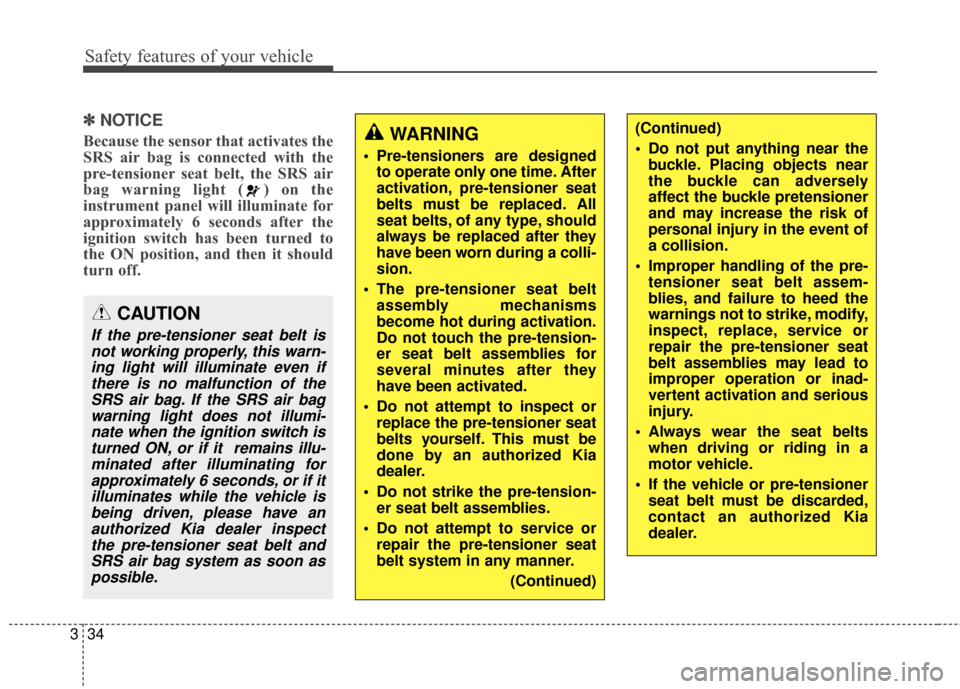
Safety features of your vehicle
34
3
✽
✽
NOTICE
Because the sensor that activates the
SRS air bag is connected with the
pre-tensioner seat belt, the SRS air
bag warning light ( ) on the
instrument panel will illuminate for
approximately 6 seconds after the
ignition switch has been turned to
the ON position, and then it should
turn off.
CAUTION
If the pre-tensioner seat belt is
not working properly, this warn-ing light will illuminate even ifthere is no malfunction of theSRS air bag. If the SRS air bagwarning light does not illumi-nate when the ignition switch isturned ON, or if it remains illu-minated after illuminating forapproximately 6 seconds, or if itilluminates while the vehicle isbeing driven, please have anauthorized Kia dealer inspectthe pre-tensioner seat belt andSRS air bag system as soon aspossible.
WARNING
Pre-tensioners are designed to operate only one time. After
activation, pre-tensioner seat
belts must be replaced. All
seat belts, of any type, should
always be replaced after they
have been worn during a colli-
sion.
The pre-tensioner seat belt assembly mechanisms
become hot during activation.
Do not touch the pre-tension-
er seat belt assemblies for
several minutes after they
have been activated.
Do not attempt to inspect or replace the pre-tensioner seat
belts yourself. This must be
done by an authorized Kia
dealer.
Do not strike the pre-tension- er seat belt assemblies.
Do not attempt to service or repair the pre-tensioner seat
belt system in any manner.
(Continued)
(Continued)
Do not put anything near thebuckle. Placing objects near
the buckle can adversely
affect the buckle pretensioner
and may increase the risk of
personal injury in the event of
a collision.
Improper handling of the pre- tensioner seat belt assem-
blies, and failure to heed the
warnings not to strike, modify,
inspect, replace, service or
repair the pre-tensioner seat
belt assemblies may lead to
improper operation or inad-
vertent activation and serious
injury.
Always wear the seat belts when driving or riding in a
motor vehicle.
If the vehicle or pre-tensioner seat belt must be discarded,
contact an authorized Kia
dealer.
Page 64 of 457

349
Safety features of your vehicle
C040900AHM-EU
How does the air bag system
operate
Air bags are activated (able toinflate if necessary) only when the
ignition switch is turned to the ON
or START position.
Air bags inflate instantly in the event of a serious frontal collision
or side collision in order to help
protect the occupants from serious
physical injury.
Also, the side and/or curtain air
bags inflate instantly in the event of
a rollover in order to help protect
the occupants from serious physi-
cal injury.
There is no single speed at which the air bags will inflate.
Generally, air bags are designed to
inflate based upon the severity of a
collision and its direction. These
two factors determine whether the
sensors produce an electronic
deployment/ inflation signal. Air bag deployment depends on a
number of factors including vehicle
speed, angles of impact and the
density and stiffness of the vehi-
cles or objects which your vehicle
hits in the collision. The determin-
ing factors are not limited to those
mentioned above.
The front air bags will completely inflate and deflate in an instant.
It is virtually impossible for you to
see the air bags inflate during an
accident.
It is much more likely that you will
simply see the deflated air bags
hanging out of their storage com-
partments after the collision.
In order to help provide protection in a severe collision, the air bags
must inflate rapidly. The speed of
the air bag inflation is a conse-
quence of extremely short time in
which a collision occurs and the
need to inflate the air bag between
the occupant and the vehicle struc-
tures before the occupant impacts
those structures. This speed of inflation reduces the
risk of serious or life-threatening
injuries in a severe collision and is
thus a necessary part of the air
bag design.
However, air bag inflation can also
cause injuries which can include
facial abrasions, bruises and bro-
ken bones because the inflation
speed also causes the air bags to
expand with a great deal of force.
There are even circumstances under which contact with the
steering wheel or passenger air
bag can cause fatal injuries,
especially if the occupant is
positioned excessively close to
the steering wheel or passenger
air bag.
Page 65 of 457
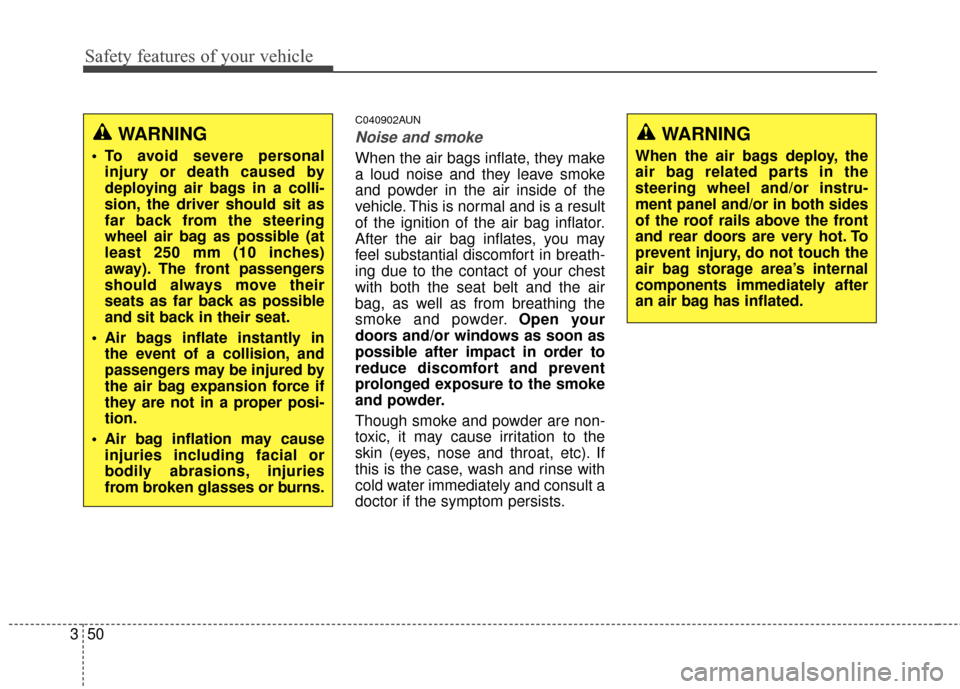
Safety features of your vehicle
50
3
C040902AUN
Noise and smoke
When the air bags inflate, they make
a loud noise and they leave smoke
and powder in the air inside of the
vehicle. This is normal and is a result
of the ignition of the air bag inflator.
After the air bag inflates, you may
feel substantial discomfort in breath-
ing due to the contact of your chest
with both the seat belt and the air
bag, as well as from breathing the
smoke and powder. Open your
doors and/or windows as soon as
possible after impact in order to
reduce discomfort and prevent
prolonged exposure to the smoke
and powder.
Though smoke and powder are non-
toxic, it may cause irritation to the
skin (eyes, nose and throat, etc). If
this is the case, wash and rinse with
cold water immediately and consult a
doctor if the symptom persists.
WARNING
When the air bags deploy, the
air bag related parts in the
steering wheel and/or instru-
ment panel and/or in both sides
of the roof rails above the front
and rear doors are very hot. To
prevent injury, do not touch the
air bag storage area’s internal
components immediately after
an air bag has inflated.
WARNING
To avoid severe personal injury or death caused by
deploying air bags in a colli-
sion, the driver should sit as
far back from the steering
wheel air bag as possible (at
least 250 mm (10 inches)
away). The front passengers
should always move their
seats as far back as possible
and sit back in their seat.
Air bags inflate instantly in the event of a collision, and
passengers may be injured by
the air bag expansion force if
they are not in a proper posi-
tion.
Air bag inflation may cause injuries including facial or
bodily abrasions, injuries
from broken glasses or burns.